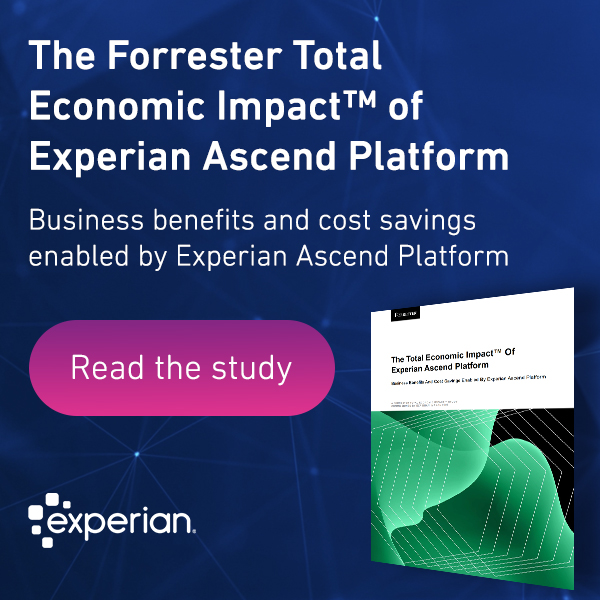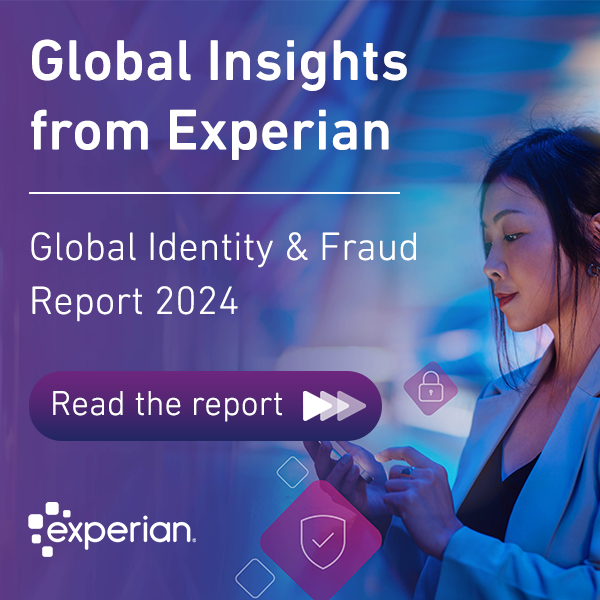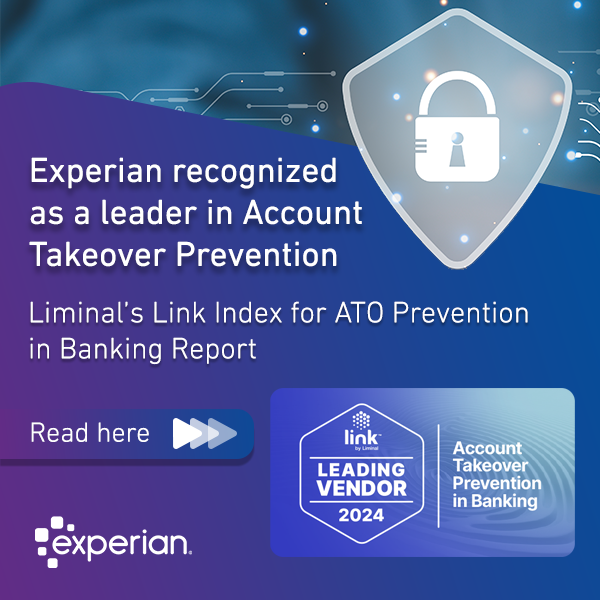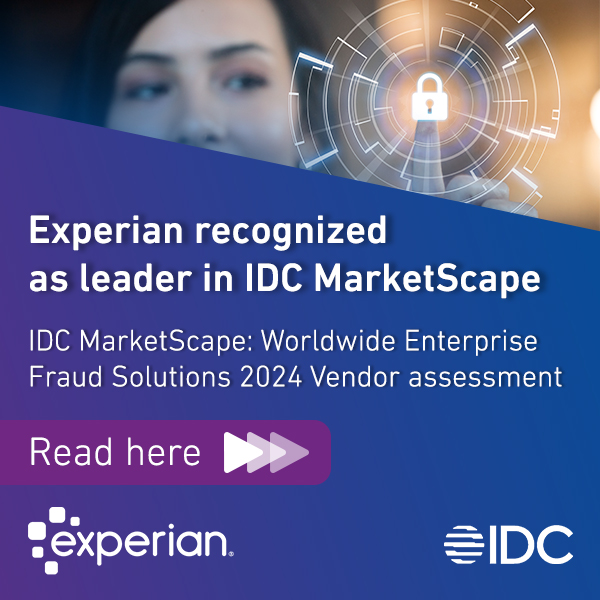Search Results for: data

Why agile data integration is key to profitability and reduced time-to-market for lenders, and how businesses are looking to cloud, alternative data sources and self-serve to enable this opportunity. “Data integration is increasingly critical to companies’ ability to win, serve, and retain their customers. To accelerate their performance in data integration, companies are evaluating and adopting a range of contributing technologies.” The Forrester Tech Tide: Enterprise Data Integration As the digital world expands, new and alternative data sources continue to emerge rapidly. With this exponential growth comes the need for financial services companies to integrate new data sources into models quickly and seamlessly. The ability to respond promptly to market changes that require new data sources can significantly reduce time to market for lenders, improving customer decisions by using a mix of traditional and alternative data that ultimately raises approval rates and, in turn, profitability. Research conducted by Forrester Consulting on behalf of Experian shows that a lack of available data is one of the three top technology pain points for tech decision-makers at financial services businesses.* According to the same research, 29% of respondents said that acquiring new customers that match the businesses’ risk appetite is a current challenge, while simultaneously reporting that credit scores still dominate data in decisioning. As more data becomes available, the gap continues to widen between what is possible, and what the reality is for financial institutions. With more data accessible through APIs, lenders have the opportunity to enhance their data analytics capabilities, leading to more personalised loan offers and cross-selling products. Our research supports this: 47% of banks and 52% of FinTechs say that increasing personalisation is a top priority. However, at the same time, data integration opportunities also pose challenges for lenders, namely around security, compliance, and cost. Data access and integration challenges As the prospect of open banking proliferates, newly proposed rules by government bodies such as the Consumer Financial Protection Bureau (CFPB) around consumer data sharing could significantly open financial data access through APIs, further enabling the potential for partnerships between financial institutions and data aggregators. Although open data access and the integration of third-party services present lenders with challenges around the cost of cloud services and total ownership, according to a recent trends report from Datos**, financial institutions will need to invest in secure, scalable, and compliant cloud infrastructure to handle the increased data flow and integration requirements. Cloud deployment: enabling data integration Adopting new credit operations technology is pivotal to data-driven strategy for lenders and deploying that technology in the right way can be critical. Cloud makes it easier to connect data feeds, allowing different internal departments to safely work with data from a variety of sources. Most respondents in our study prefer cloud-based technology, with 83% citing that a cloud or hybrid solution is the preferred deployment option and just 17% seeking on-premises deployment. Self-serve data integration Another key component of agile data integration is enabling users in-house to manipulate data sources flexibly. By speeding up the data integration process with low-code and no-code platforms and tools, businesses can customise their APIs regardless of in-house team experience, allowing data integration to happen in days instead of weeks. “Increasing use of low-code and no-code capabilities give business users the ability to create more customized and packaged business analytics capabilities with business-centric modularity and embed into applications via APIs to serve their business objectives.”Gartner’s Top Trends in Data Analytics, 2023 Improving data integration is central to the quest for speed and agility in today’s credit risk market. With 25% of business respondents citing that they prioritise investment in initiatives that accelerate time to market in response to business and market changes, organisations are ready to capitalise on the opportunity. According to Datos, in 2024, next-generation core banking platforms are poised to address these challenges, providing flexibility, agility, and configurability, along with cloud-native benefits, ensuring financial services institutions stay competitive in the rapidly evolving technological landscape.** Learn more about PowerCurve *In a study conducted by Forrester Consulting on behalf of Experian, we surveyed 660 and interviewed 60 decision makers for technology purchases that support the credit lifecycle at their financial services organisation. The study included businesses across North America, UK and Ireland, and Brazil. **Datos Top 10 trends Retail Banking Payments 2024

Fraud prevention is a critical concern for businesses today. To help combat this ever-present threat, the consortium approach has emerged as a powerful tool in the fight against fraud. By pooling resources, expertise, and creating visibility, consortium members can be more effective in detecting and preventing fraudulent activities. con-sor-tium noun: A group of people, countries, companies, etc., who are working together on a particular project. What is a consortium? Within business, consortiums are a global concept and can operate under multiple categories, including finance, marketing, and tech. A well-known, successful example is Star Alliance. They are a group of airlines, whose agreement enables their members to share and benefit from flights, airport lounges, and frequent flyer programs. All Star Alliance members are working towards the same goal, which is to offer their customers a seamless travel experience. Key benefits of the consortium approach Resource sharing: Pooling resources like funding, expertise, and infrastructure can lead to cost savings and efficient resource utilisation. Risk mitigation: Shared risks make it easier for organisations to tackle ambitious projects or ventures with reduced individual exposure. Access to expertise: Members can tap into the collective knowledge and skills of the consortium, enhancing their capabilities. Market influence: Consortiums often have more influence in negotiations, regulations, and standards-setting, benefiting all members. Innovation: Collaboration can foster innovation through cross-pollination of ideas and technologies among members. Economies of scale: Consortiums can negotiate better deals on purchases or services due to their combined purchasing power. Reduced competition: In some cases, members can reduce direct competition among themselves by coordinating efforts. Market entry: Consortiums can facilitate market entry, especially in foreign markets, by leveraging each other's networks and knowledge. Shared infrastructure: Access to shared facilities or infrastructure can save costs and accelerate projects. Brand recognition: Being part of a reputable consortium can enhance an organisation's credibility and market presence. However, consortiums also come with challenges such as coordination issues, conflicts of interest, and shared decision-making. Successful consortiums require effective governance structures and clear agreements among members. Consortiums in fraud detection and prevention The success of a consortium relies on the collective commitment of its members to a shared goal. In the context of fraud prevention, this means maintaining consistent and high-quality insights across all members. To achieve this, consortium members adhere to an agreement that covers elements such as data quality and data frequency. These agreements ensure that all participants contribute their best insights and information. By fostering a culture of cooperation and sharing, consortiums create an environment where valuable insights can be harnessed to combat fraud effectively. However, it's crucial to emphasise that the success of consortiums ultimately depends on the active participation and contribution of all its members. Consortiums can only thrive when every member is dedicated to making their quality insights accessible to the group. Read more about how consortiums can revolutionise fraud detection and prevention by sharing data on fraudsters across different product types and industry sectors with Hunter.

With an ever-growing number of data sources, businesses must be able to rapidly access and integrate them into decisioning processes using no-code tools to stay ahead of the competition. Today’s customer journey has become increasingly sophisticated. As most firms that interact with customers can attest, this journey is a dynamic process shaped by a range of decisions. Businesses need to decide what is the most compelling offer to deliver to a new customer. Should you approve their loan application? Could the customer gain more from sustainability-linked loans or greener mortgages? What is rich data? These diverse decisions are ideally informed by rich data. This is all the available data, including new data derived from analytics using advanced techniques such as Machine Learning and using rules to make predictions and to calculate scores. While most firms have this data, it is difficult to gather, prepare and integrate into the decisioning processes. Multiplicity of data sources Data types and sources are growing. With regulatory bodies gradually approving the use of more data globally, businesses are faced with an opportunity dressed up as a challenge. Speedy integration of different data sources gives organizations a competitive edge, so finding vendors that can enable firms to utilize available data will positively impact them from a cost efficiency perspective, while also creating the potential for revenue growth. The future is to empower business users with no-code data management No-code data management capabilities add a whole new meaning to self-sufficiency for businesses. It will enable teams across organizations to rapidly change data-driven strategies without much vendor involvement. Gartner estimates that by 2025, 70% of new applications developed by enterprises will use low-code or no-code technologies, up from less than 25% in 2020. Moving towards client self-service with no-code capabilties is the goal of most businesses. These capabilities are already allowing teams supporting clients to rapidly integrate data sources into their solutions, providing the perfect test ground for business user enablement. If a decision strategy requires changes and a new data source, PowerCurve users can quickly adapt. They can now gather and prepare the right data and deliver it to the system within days. These changes can be instantly published through secure and easily adjustable APIs that support the latest industry standards and frameworks such as OpenAPI and OAuth. An effective customer journey relies on informed decisions and these decisions rely on the right data and advanced analytics. While Experian's PowerCurve platform is well known for automating a range of decisions across the customer lifecycle, it is the data integration capabilities that ensure these decisions are informed by rich data and insights. Creating a harmonious relationship that produces superior and trustworthy results for businesses. No-code data management enables businesses with easy and rapid data source access to deliver rich and insightful data to decisioning processes.

In today's fast-paced digital landscape, businesses are inundated with an unprecedented amount of data and information. Making informed decisions with the data quickly and effectively has become a crucial factor for success. Enter digital decisioning—a transformative approach that harnesses the power of data, analytics, and automation to drive reliable and expedited decision-making. This article delves into the world of digital decisioning, exploring its significance, components, and benefits. The Essence of Digital Decisioning At its core, digital decisioning is the process of leveraging software solutions that use digital decisioning platforms or custom-built engines to author decision logic; use decision intelligence technologies such as machine learning and AI; use digital decisions in vertical and horizontal use cases; and manage the full decision logic lifecycle, including feedback loops, to continuously improve decision logic. It enables organizations to make well-informed choices by automating and optimizing complex decision processes. By amalgamating data from various sources in real-time, including credit data, user behavior, market trends, historical data, and external factors, digital decisioning ensures that timely decisions are not only data-driven but also contextually relevant. Components of Digital Decisioning Continuous Data Feed: This is the lifeblood of digital decisions. Organizations normalize data from disparate sources to form comprehensive and accurate datasets. Customer data might include income, credit history, transactional data, bill payment, or digital footprint data; however, regardless of the sources, it’s critical that data is coalesced into a single, virtualized view. Advanced Analytics and Machine Learning: Analytics and machine learning algorithms are deployed to extract meaningful insights from the collected data. These insights are used to model decision scenarios, predict outcomes, and uncover hidden patterns. Decision Models: Decision models are created based on the insights derived from data analysis. These models define the rules and logic for making decisions, incorporating factors such as risk tolerance, business goals, and regulatory compliance. Direct Feedback Loop: Every decision has an outcome. For example, an automated loan offer is either accepted or declined by the customer. These outcomes — good and bad — automatically feed into the decisioning model, which enables the machine learning technology to “learn” which decisions are optimal, given the circumstances and customer profile. This enables the model to adapt and grow more accurately and precisely over time. Automation: Automation engines execute the decision models in real time, allowing for rapid and consistent decision-making without human intervention. This enhances efficiency and minimizes the risk of errors. According to a 2022 Gartner poll, the CIO Agenda, more than 80% of companies plan to keep or grow their investment in automation solutions. Benefits of Digital Decisioning Enhanced Accuracy: Digital decisioning eliminates human biases and inconsistencies, resulting in more accurate and objective decisions. Improved Efficiency: Automation reduces decision-making time from hours or days to milliseconds, enabling organizations to respond swiftly to market changes and customer demands. Hyper Personalization: By considering individual preferences, behaviors, and history, digital decisioning facilitates the creation of tailored experiences for customers, leading to higher satisfaction and engagement. Scalability: The automated nature of digital decisioning ensures that it can handle a high volume of decisions seamlessly, making it ideal for businesses experiencing rapid growth. Regulatory Compliance: Explainable decision models can be designed to incorporate regulatory guidelines and compliance requirements, reducing the risk of legal complications. Use Case: Respond faster to credit card applications and personalize cross-sell offers Customers apply online for a credit card from a bank. As they’re being pre-qualified, digital decisioning will instantly analyze the customers’ accounts with the bank including disclosed and undisclosed cash flow. A digital decisioning software solution enables the bank to assess risk exposure and anticipate the customer’s immediate need(s), thereby automating the application assessment and approval steps to reduce approval times from weeks to minutes. Based on the bank’s comprehensive understanding of that customer at that moment, it triggers a personalized cross-sell offer for another relevant financial product, automatically boosting incremental revenue. Conclusion Digital decisioning marks a pivotal advancement in how choices are made in business. By harnessing the power of data, analytics, and automation, organizations can make faster, more accurate decisions that are aligned with their goals and market realities. As this technology continues to evolve, it will reshape industries and empower individuals to navigate the complex digital landscape with confidence. Experian’s decisioning management platform allows clients to operationalize the power of rich data, advanced analytics, and automated decisioning software to support the customer lifecycle. Its key differentiators include credit risk, fraud risk, and strategy expertise, fast deployment of strategies into test and production, empowerment of business users, and proactive monitoring of strategy performance by users. Its key use cases include reducing acquisition costs, credit risk, and fraud risk, and improving acceptance rate and the customer journey. Experian has been named a Technology Leader in the August 2023 SPARK Matrix on Digital Decisioning Platforms report published by Quadrant Knowledge Solutions. The report highlights the growth of decisioning platforms and the changing market trends that are driving adoption, including the role machine learning and AI are playing in the technology market. This placement is proof that Experian offers best-in-class capabilities through market-leading data, orchestration and automation, advanced analytical models, decision performance, and reporting. Our cloud-based infrastructure enables a scalable and modular platform that allows our solutions to be suitable for customers of all sizes. Read the report Experian’s Decisioning Management Platform: Accelerating analytics, decisioning, and fraud detection automation Continuous improvement loop: Advanced machine learning models improve decisioning quality

Did you miss these July business headlines? We’ve compiled the top global news stories that you need to stay in-the-know on the latest hot topics and insights from our experts. Digital experience is a key priority for the post-covid consumer TechWire Asia reports on data from Experian’s latest Global Insights Report to look at consumer expectations and the digital experience businesses can offer as consumers spend more time online. Experian CIO on digital identity, personalization and building trust with consumer data Kathleen Peters, NA Chief Innovation Officer, speaks with Finovate in this interview discussing the 2022 Global Identity & Fraud Report and thoughts on digital identity and how financial services companies can use consumer data to their advantage 91% of Indians prefer online payment methods Business Today India reports on findings from the Global Insights report, with digital payments having overtaken credit cards with 91 percent of Indians preferring online payment methods. Spain, the second country most concerned about online fraud CSO Computer World explores the findings from the 2022 Global Identity & Fraud Report from a Spanish consumer perspective, revealing that Spain is the second country most concerned about online fraud globally. Stay in the know with our latest research and insights:

Did you miss these April business headlines? We’ve compiled the top global news stories that you need to stay in-the-know on the latest hot topics and insights from our experts. Experian Named Top Provider of Digital Identity Juniper Research acknowledges Experian as an established leader in digital identity in its competitor leaderboard, highlighting the flagship identity and fraud platform, CrossCore™. The report also looks at the key areas of digital identity and where its headed. What’s the hardest part about using synthetic data correctly? Braintrust, Protocol's experts on the biggest questions in tech, talks to Eric Haller, VP and General Manager of Identity and Fraud and Datalabs, about using synthetic data and what challenges are involved in the process. Passwordless MFA: The Single Way To Mitigate the Top 5 Threats to Your Customer Identities As cyber criminals discover new methods to compromise consumer accounts, forward-thinking organizations are adopting solutions for better security and a smoother customer experience. Experian Finds Mobile Wallets Rival Traditional Payment Methods The new Experian Global Insights Report concludes that digital online spending will continue to gain strength even as consumers emerge from lockdown and return to in-person transactions. 6 e-commerce cyber fraud challenges in 2022 Mike Gross, VP Applied Fraud Research and Analytics, discusses the biggest cyber fraud trends predicted to come up in 2022. From deepfake fraud to fraud as a service, and the developing relationship between digital identity and verification with fraud detection. Stay in the know with our latest research and insights:

The ecosystem of credit lending platforms and technologies has rapidly grown in the past year. Lenders now find themselves in an increasingly competitive market with new players emerging on the scene. More companies now have access to advanced analytics and automation capabilities, and this is helping businesses improve the accuracy and inclusivity of consumer lending decisions – a giant step toward achieving their growth ambitions. Our recent research shows that one of the top priorities for businesses has been to invest in new artificial intelligence and machine learning models for smarter customer decisions. But how effective is building new AI models without considering the data? What is data-centric AI? Building AI models on fixed data has already become an outdated approach. But by coupling data with the best model, better outcomes can be achieved. The concept of data-centric AI was coined by leading thinker in the AI space, Andrew Ng. Ng believed that models in production are only as good as the point-in-time data used to build them. As businesses continue to receive new data, this data needs to feed back into the model if it’s going to continue delivering the best results. This continuous loop of enriching the model with new data can be applied across use cases. The value of data-centric AI models for acquiring new customers By using the latest available data, rather than from 6-12 months ago or longer when the model was originally developed, data-centric AI models can: • More rapidly account for changes in the economy and consumer finances • Reach under-represented populations and provide greater access to credit • Take advantage of newly available types of information from data providers The value of data-centric AI in existing frameworks More observations AI is often limited by the data that was used to create the model. By using a more fluid open-source alternative, different data sets can be inputted to get more observations based on different characteristics and findings. For example, if a business wants to acquire a new type of customer, traditional AI would require a new model with new data sets to be in order to target this new customer. With data-centric AI, businesses can use an existing model and simply expand the data, thus allowing the model to work far more efficiently and target a new consumer base. It is a shared view that businesses should not build models with just their own data, because those data sources are too limited. At the very least, businesses want to combine data with a peer sample. However, an even better way is to use hybrid data sets in order to get the most observations. Data-centric AI makes that process easy without the need to create different models to see different outcomes. Up-to-date data The world is in a state of flux—populations change, people change. This means that the data pools AI models draw on may be compromised, no longer relevant, or have new meaning over time. It’s important to keep AI data sets recent and up to date, and not assume that the models used two years ago still apply today. For AI models to operate efficiently they need current, relevant data. Having a data-centric approach and sweeping through collected observations is essential for any business relying on their AI solutions. Businesses must have processes to understand and test their data to be sure the values are still adding up to what they should be. Being disciplined about data hygiene, all the way back to the source, is a necessity. Enriched and expanded data With model-centric AI, businesses are limited by the data they start with. Data-centric AI makes it possible to expand on the current customer base, which already includes data on customer attributes, with new potential customers that might mimic characteristics of a business's current base. Expanded data can also play a role with financial inclusion and credit worthiness. Having a low credit score does not necessarily mean the consumer is a bad risk or that they shouldn't be allowed access to credit—sometimes, it could mean there is simply a lack of data. Expanding data to include varied sources and adding it to current models without changing their structure, enables businesses to provide credit for individuals who may not have originally been accepted. This new approach in AI is creating solutions that are far more inclusive than previously possible. Data has massively expanded and is constantly evolving. By using data combined with advanced analytics, such as AI, there will be more sophistication in the observations that come from the data. This will allow businesses to better decide what data they choose to rely on while ensuring accuracy. By using expanded data sources, the outcomes of models are changed, leading to more inclusive models better fit for decision making and improving performance. "Models in production are only as good as the point-in-time data used to build them." Andrew Ng Infographic: Why data-centric AI leads to more accurate and inclusive decisions Stay in the know with our latest research and insights:

The ecosystem of credit lending platforms and technologies has rapidly grown in the past year. The top business priority emerging from the pandemic has been to prioritise investments in new artificial intelligence and machine learning models for smarter customer decisions. According to our latest report, business confidence in AI is growing: 81% up from 77% last year. Three reasons why data-centric AI models lead to more accurate and inclusive decisions More observations to better represent the population Easy o update with the most current data Enriched and expanded data sets for a complete view of the customer Stay in the know with our latest research and insights:

One of the most exciting things about financial services innovation is our growing ability to deliver personalized customer experiences. For example, consider a customer who enters a shopping center during the holiday season. By leveraging decisioning software, lenders can proactively offer that customer more credit—in real-time. The person has the financial ability to get what they need and doesn't have to experience a rejected transaction based on previous credit availability. What's behind such personalized offers? They are powered by the latest data—information that goes far beyond traditional credit ratings and references. For the holiday shopper, that may include geolocalization and behavior data that project a customer's likelihood of reaching a credit limit while shopping. The information empowers lenders to provide that personalized experience at the exact right time. But to make that possible, the data must be interoperable across systems, analytical and operational environments, and third-party data providers. Looking ahead, the financial service companies that enable this interoperability will be able to innovate faster, compete better, and scale their personalization to ultimately win more business. Why interoperability matters Our most recent Global Decisioning Research Report denotes consumers' evolving expectations and the increasingly vital role data and analytics play in meeting their needs. Financial service companies must leverage data to understand customer circumstances better, changing risk profiles and emerging credit needs, especially as we move out of the pandemic. Indeed the right data can help lenders support customers across their entire journey. But utilizing data to improve the customer experience is not as straightforward as it seems. The amount and diversity of the data available are huge. And the data required to power personalized products and experiences are not always readily accessible, well-formed, or high quality. As a result, data integration projects often take longer and cost more than many financial service companies anticipate. Legacy systems add to the complexity and expense. The evolving open standards for data interoperability are helping alleviate some of these challenges. But companies still need to determine which standards and platforms to use. Selecting the right ones can accelerate innovation and prevent expensive stops, starts, and detours down the road. Cultivating a healthy ecosystem The good news is that these challenges are surmountable. The first step is to understand where your organization is in its data interoperability journey. Then you can create a strategy that makes data-based innovation easier, faster, and more cost-effective. For example, consider: Prioritizing industry-leading open standards for interoperability. Requiring CSV and JSON data formats is smart; both are currently ubiquitous across the industry. Using standard APIs to share data. For example, Rest APIs using Swagger provide a description of the API, the data and facilitate the discoverability and use of the API. Exploring API aggregation services and marketplace platforms. These make it easy for developers to add services and for your organization to put them to use. Leveraging low-code data integration tooling. This helps you remove data silos and empower staff to navigate older, traditional data integration methods until they evolve to use open standards. These actions can make a significant impact on your company's ability to take advantage of various data sources now, as well as set your organization up for the future. Data meets decisioning Selecting the right decisioning software is a crucial way to facilitate the steps noted above. As you consider decisioning solutions, look for products that allow you to publish and consume data using open APIs and simple visual drag and drop approaches. In addition, evaluate the core data management capabilities of potential solutions, and prioritize those that can natively also support semi-structured data. For instance, applications that allow you to leverage frequently changing data sources ensure that when a source evolves, only the specific areas loading the data are impacted—not the wider solution. Lastly, as mentioned above, solutions that provide lightweight, low-code middleware allow you to leverage third-party data no matter where you’re at in your interoperability journey. Those new sources of data will inform and enhance your customer's experience. Stay in the know with our latest research and insights:

How elite leaders train analytics teams to unearth and convey the highest quality data insights and better manage risk. It's surprising how much of an art the effective use and analysis of qualitative data in the business world truly is. Too often, data scientists are tasked with turning raw data into insights without ever actually being taught the true art of identifying and reporting the most meaningful insights that address the problems at hand. Instead, data teams often produce reams of summarized information without drawing any useful conclusions – falling short of discovering deeper truths hidden within. I've been fortunate to work for, with, and manage data scientists of various titles, abilities, and personalities over the years. I've found that the true "artists" in this profession can combine technical proficiency, tactical communications with an affinity for the science, and excellent detective skills. Objectivity in Data Analysis As Arthur Conan Doyle wrote in Sherlock Holmes says, "I never guess. It is a capital mistake to theorize before one has correct data. Insensibly one begins to twist facts to suit theories, instead of theories to suit facts." As data scientists, we're often sent down a singular path to analyze data to support a narrative. Data is inherently objective; analyzing with subjective intent typically leads to ineffective results when put into practice. However, with the proper guidance, probing questions, and some detective work, scientists can uncover deeper insights leading to effective outcomes in the form of actionable intelligence and forecasts. Early in my career, I was tasked by a business partner to pull data that demonstrated higher customer satisfaction scores for a customer call center. Requests like this – "just get me the data" – are (unfortunately) common. In this case, however, he was open to discussing the "why" behind his ask. As a result, this incident proved a learning opportunity for me on how to satisfy a requirement while simultaneously producing information explicitly valuable to the organization. I've often had to find workable paths through figurative minefields with mandates such as "just get me the data" or "make the numbers work." During this scenario, I diligently asked ancillary questions to build into the data modeling outside the required parameters. I intended to generate value beyond the pre-conceived conclusion I was tasked with finding data for. The resulting report yielded compelling insights, actionable intelligence, and a clear forecasting plan. In this example, it was found that clients had higher satisfaction scores for reasons other than what we initially thought and had nothing to do with the seven million dollars my business partner spent on branding, training, etc. The solution was simple: move a training location. Tactical communication skills were necessary in this scenario as I had to tell my business partner where the efficiency gains were actually coming from and where future budgets could be more effective. Doing so was the catalyst behind an alternative business strategy and focus, resulting in a much more significant impact on our customer relationships. Asking the Right Questions The true purpose of analytics is to discover, interpret, and communicate meaningful patterns in data and the connective tissue between. Most importantly, it exists to aid in effective decision-making within an organization. Under that premise, I teach my teams to be communicative, especially during planning stages and consistently ask questions of the data throughout the analytical process. It's always imperative to identify the specific addressable problems our clients are trying to solve while frequently conversing with them to understand what actions and/or decisions the analysis is meant to inform. This strategy produces more profound results and focuses on solving a problem – not endlessly cycling through various cuts of the same data. As a result, the team will be primed to evaluate results objectively and be ready to dig beyond surface-level data, capturing vital insights hidden deep within. Using the Right Tools Nobody does arithmetic by hand anymore. A data scientist's best friend should be sophisticated model development software that leverages AI and Machine Learning. The efficiency they provide enables us to focus on areas where human intelligence is best applied, such as interpreting model performance within the context of how that model will be used. Elite leaders know how to leverage the right tools to maximize speed and efficiency. Ignoring the sheer processing power of cloud computing and other advancements places your organization at a distinct competitive disadvantage in performance and accuracy. I shudder when thinking about the dark days when it would take six to nine months to develop a new model. It reminds me of watching NASA mathematicians do advance calculations with slide rules in movies like Apollo 13 and Hidden Figures. Strategy optimization is a perfect example; how do I ensure that my portfolio is holistically delivering the highest value within risk constraints? I could grow my portfolio endlessly, but that likely means taking on too much back-end risk. Instead, mathematical optimization can be used to determine the right balance between growth, return, and risk. To do this successfully requires a vast amount of processing power. Gradient boosting, a Machine Learning technique that helps build far more accurate models, is another excellent example of what's possible with modern technology. Some of the operations we perform daily were literally not possible 10-15 years ago as we did not have access to such processing power. Thus, we're able to solve problems not previously solvable. What has also changed is our ability to process volumes of data and highly complicated, multi-tiered models, with extreme speed and efficiency. Organizations don't need to take all of this on, as companies like Experian effectively provide data science services where AI/ML solutions are delivered rapidly and digitally. A well-equipped, efficient, curious, and well-trained data team whose data analysis consistently helps corporate leaders make informed decisions is true art. The answers they provide to challenging business questions is their magnum opus. Read about topics related to this article Stay in the know with our latest research and insights:

Credit providers have long relied on data to lend insights into how their customers are faring—and help predict what's to come. The pandemic, however, introduced unexpected anomalies that have made understanding the actual credit landscape far more challenging. For example, while government assistance programs have enabled customers to stay up-to-date on their payments, they've also made it harder to discern the true financial impacts of the crisis. Our recent research gives voice to these challenges. We surveyed businesses around the world three times from July 2020 through January 2021 for our annual Global Decisioning Report. The results reveal that business confidence in credit risk analytics models has declined over the pandemic, dropping by nine percentage points for Tier 1 lenders, and 15 percentage points for Tier 3 lenders. As we look ahead, credit providers need ways to improve confidence in their analytics models so that that they can make smarter, faster decisions on behalf of their customers and businesses. This is where synthetic and alternative data are beginning to make a real difference. The rise of AI and machine learning solutions has opened the door for lenders to leverage this data. Understanding how to put it to use—and why it's imperative to do so—will help lenders navigate the end of this crisis and prepare them for any economic volatility in the future. The data differentiator Before we dive into how lenders can best utilize alternative and synthetic data, let's quickly define what we're discussing. Credit providers have traditionally used credit bureau data to assess their portfolio risk and inform credit decisions. But as noted, in times of crisis, supplementing that data with additional context can significantly improve its effectiveness. Alternative data does just that. Alternative data refers to primarily unstructured data from non-traditional sources. For example, social media data can help paint a more complete picture of customer behavior. And location data can provide information about customer geography, such as opportunities for travel-related purchases. Synthetic data complements alternative data but is not the same. Synthetic data is new data created by altering existing data. So a lender might change the profile of its customer base and then use that dataset in analytics models to better understand what the future may hold. Both types of data work together, with alternative data providing a more complete customer view and synthetic data allowing lenders to account for additional variables and offset their risk accordingly. New data in action Confidence in analytics models may have dropped during the crisis. But lenders aren't resting on their laurels. Instead, nearly half of businesses report that they are dedicating resources to enhance their analytics efforts. Those that include alternative and synthetic data in their improved models have the opportunity to leverage the information in multiple ways. Some of the most exciting applications of alternative and synthetic data include: Anticipating purchasing behavior New data sources, especially from social media, help lenders understand what's happening in their customers' lives and how that may translate into purchases. For example, a customer who has recently moved into a new home may be considering purchasing furniture or home décor. Or customers who are celebrating life milestones such as birthdays or graduations may be buying gifts or spending on events. Predicting credit risk In this realm, synthetic data can be beneficial. Lenders can use synthetic data to understand how credit profiles may change in specific circumstances, such as modeling a higher unemployment rate or dramatic income shifts. They can then use analytics models to determine the related impact on customer affordability. Improving fraud detection With an improved customer view, fraud prevention teams can more easily identify unusual patterns in customer behavior and spending. For instance, does a customer's current location (per location data) match their most recent transactions? Or has the number of contacts on their phone dramatically changed (it may not be their phone)? Enhancing pricing Both types of data are useful in improving pricing models across company portfolios and at a personal level. The additional context can help everyone from lenders to insurers to banks assess customer needs and provide products that meet them—at prices that make sense. What's more, machine learning automates that pricing, allowing companies to scale personalization across the organization. Improving marketing In the same vein, new sources of data can also give marketing efforts a boost. The ability to access more real-time information about customer behaviors uncovers opportunities to provide them with credit, insurance, and other lending products that may prove immediately helpful. Data can also help identify new markets entirely or highlight rising needs that may demand the development of additional products or services. The past year was an anomaly in so many ways. However, as we ease out of the crisis, financial service companies have the opportunity to strengthen their data models—and leverage new types of data to reduce their risk and provide improved decisioning no matter what the future holds.

As we enter the beginning of the end of this global crisis, the role of data, analytics, and credit risk decisioning takes on even greater significance than before. Consumers face uneven roads to recovery, with some ready to spend again and others still mired in pandemic-related financial stress. And businesses of all sizes report their operations are recovering but there’s still a way to go. A key difference we saw is that companies that adapted to serve customer needs digitally are faring much better. Our 2021 Global Decisioning eBook, Navigating a new era of credit risk decisioning, looks at how consumers are stabilizing their finances and how businesses are returning to growth. A recent survey among 9,000 consumers and 2,700 businesses across ten countries worldwide reveals the importance of lenders prioritizing digital transformation, and the role of advanced data and analytics in enhancing the customer experience. The pandemic fall-out is impacting everyone differently: 1 in 3 consumers remains concerned about their finances – paying bills and managing credit Whereas high-income households are no longer reducing their discretionary spending Navigating this varied credit landscape requires a deep understanding of customer needs on both ends of the spectrum. However, business confidence in the consumer credit risk management analytics models dropped over the past year from 71 percent to 61 percent. Smaller lenders with revenues ranging from $10M to $49M have seen the sharpest decline from 72 percent to 57 percent in the past six months. Adapting data and analytics to a rapidly changing customer base: Almost 50% of businesses surveyed said their dedicate more resources to enhance analytics One-third of businesses are planning to re-build their models from scratch Recalibrating credit models is one thing, but lenders also need to rethink their data sources to better understand current customer profiles. The data inputs generated by the pandemic have impacted credit risk models and machine learning applications in unexpected ways. For example, widespread payment holidays and government stimulus programs may be masking customers’ true financial circumstances. According to Recovery Insights, a separate study published by Experian North America: Delinquency prior to the pandemic is a strong indicator of future risk. Accounts exiting an accommodation period are 2x more likely to become delinquent than are accounts that never received an accommodation. Payment on debt during accommodation indicated a reduced risk for subsequent delinquency. Amidst the pandemic lockdown, consumers turned online to manage finances and connect with lenders – including older consumers. And while the pandemic pushed consumers online out of necessity, now that they’re there – it’s become a preference – as overall digital gains are holding above pre-pandemic levels. Lenders have a new digital imperative to meet consumers’ evolving needs for continued digital engagement. Consumer expectations of digital experiences 55% of consumers have higher expectations of their digital experience since Covid-19 began 43% of consumers surveyed age 70+ reported digital banking throughout the pandemic 14% of consumers surveyed age 60-69 applied for a new loan or card online The importance of a digital-first approach has revealed itself and many companies have put a digital customer journey in place since Covid-19 began. The future, however, is more than providing online services. It’s about knowing your customers well enough to anticipate their credit needs and using tools to automate the process and reduce risk. Adapt or lose customers 9 in 10 businesses have a digital customer journey in place 1 in 4 consumers have taken their business elsewhere because a company didn’t adapt to their digital needs Online customer experience and credit risk management are more connected than ever before. And, businesses need technology that supports the entire customer journey, from onboarding to customer management to collections. Five digital investments businesses are prioritizing the new era of credit risk management: Implement new machine learning models for customer decisions Increase digital acquisitions and engagement Understand their customer base (affordability, value, behavior) Automate customer decisions Increase value of existing customers Access the report here to get more consumer trends and find out what the future of decisioning means for businesses looking to return to growth. Stay in the know with our latest insights:




